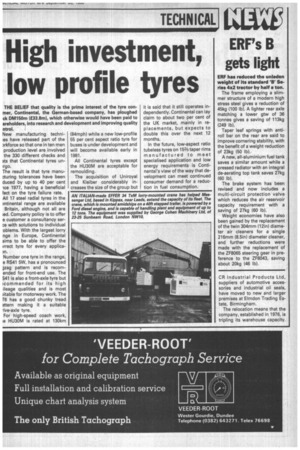High investment, low profile tyres
Page 23

If you've noticed an error in this article please click here to report it so we can fix it.
THE BELIEF that quality is the prime interest of the tyre conmer, Continental, the German-based company, has ploughed ck DM150m (E33.8m), which otherwise would have been paid to areholders, into research and development and improving quality ntrol.
New manufacturing technies have released part of the 3rkforce so that one in ten men production level are involved the 330 different checks and sts that Continental tyres unrrgo.
The result is that tyre manuturing tolerances have been duced by up to 40 per cent ice 1977, having a beneficial Fect on the tyre failure rate. All 17 steel radial tyres in the )ntinental range are available Britain, although not all are ;ed. Company policy is to offer e customer a consultancy serce with solutions to individual oblems. With the largest lorry nge in Europe, Continental aims to be able to offer the irrect tyre for every applicaan.
Number one tyre in the range, e RS41 5W, has a pronounced gzag pattern and is recomended for front-end use. The S41 is also a front-axle tyre but :commended for its high ileage qualities and is most litable for motorway work. The T6 has a good chunky tread 3ttern making it a suitable lve-axle tyre.
For high-speed coach work, re HU3OM is rated at 130km (84mph) while a new low-profile 55 per cent aspect ratio tyre for buses is under development and will become available early in 1981.
All Continental tyres except the HU3OM are acceptable for remoulding.
The acquisition of Uniroyal and Kleiber considerably increases the size of the group but it is said that it still operates independently. Continental can lay claim to about two per cent of the UK market, mainly in replacements, but expects to double this over the next 12 months.
In the future, low-aspect ratio tubeless tyres on 152/3 taper rims manufactured to meet specialised application and low energy requirements is Continental's view of the way that development can meet continued consumer demand for a reduction in fuel consumption.






























































































































